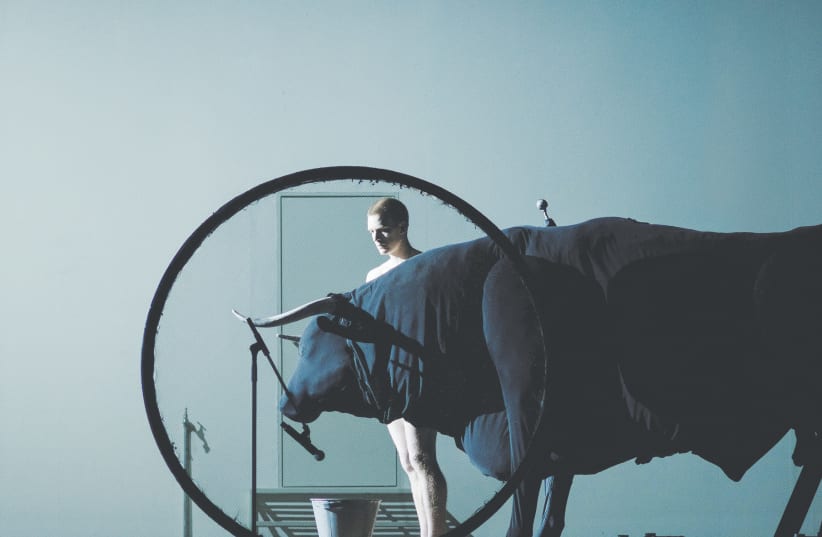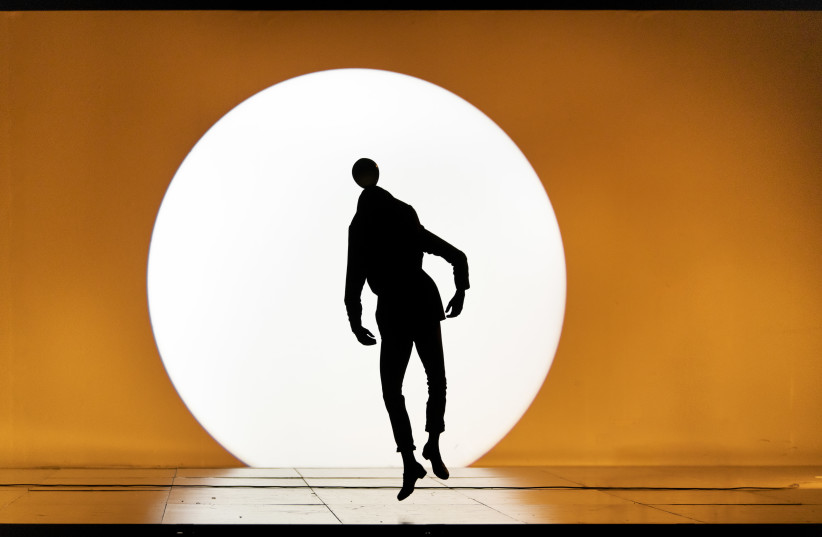The renowned Greek choreographer Dimitris Papaioannou will be coming to Israel with his new creation Transverse Orientation, which just won the prize for Best New Dance Production at London’s 2022 Olivier Awards.
In the text following the announcement, the award committee called the choreographer “A true master of visual spectacle. Papaioannou explores existential themes, mining mythology and art history to conjure vivid and often humorous imagery. Taking inspiration from the natural behavior of moths to seek light, Transverse Orientation follows the human compulsion to find meaning on the journey of life.”
Born in Athens in 1964, Papaioannou gained early recognition as a painter and comics artist, before his focus shifted to the performing arts, becoming a director, choreographer and performer, as well as being a designer of sets, costumes, make up and lighting. He formed Edafos Dance Theatre in 1986 as an initial vehicle for his original stage productions, hybrids of physical theatre, experimental dance and performance art.
Originating in the underground scene, the company has gained an expanding number of followers. Considered to be its iconic work, Medea (1993) marked the company’s transition to big theaters. Papaioannou became widely known in 2004, as the creator of the opening and closing ceremonies of the Athens 2004 Olympic Games.
TRANSVERSE ORIENTATION opens in an empty room. An annoying fluorescent light flickers as comics-like creatures move about and struggle with a stepladder. But this humorous prelude does not prepare you for what is in store next.
Out of the darkness, a huge bull appears against an orange sun. This image of a life-size bull brought to life by the dancers is so impressive, you sometimes believe it is alive. Later the reference to the Minotaur is clear when, as in Greek mythology, the bull symbolizes the old fighting the young in a “dance” with a male dancer.
“In the story, I try to play with the idea of archetypes because they move people without having to explain,” Papaioannou said. “When we talk about archetypes in Western civilization, we inevitably end up in Greece. In this regard, I have the extra luck to have had Greek culture as my upbringing culture.
“In the case of the Minotaur, I had the excitement about the duel between the young man and the old man – the beast – like the previous and the next. I have always had that curiosity, and now – because I wanted to create this bull puppet, it slides towards the Minotaur easily. She [Europa] fell in love with the bull and she hired the genius Daedalus to construct a female bull so she could climb inside and be impregnated by the bull.”
The scenes follow each other, merging images seamlessly, moving from comics to Greek mythology to Botticelli’s Venus; from ancient marble statues to expressionism.
But this show is not only for art lovers. “People that love art may have some extra pleasure. If you tune in and enjoy the work – when you get more references you enjoy it more,” the award-winning choreographer said. “But sometimes it is also a trap – people may look for meaning in the references but it is just a game – a game I play with my audience. And as I try to take you on a journey that is not exactly comprehensible, I don’t know exactly what feels right, and maybe it is cathartic and emotional: It is nice to have something to hold on to.
“I don’t like my works to be a series of compositions and beautiful images,” continues Papaioannou. “I very much concentrate on how things morph, how an image morphs – this is the choreography – so it’s the progression from one to the other that interests me. That is where I base the emotion and that’s where I am, because if you see a series of images and you think you get it, you never see the way that they are – and this is how time works.”
That is “how I try to manipulate the sense of time, which is very basic in motion. Many people confuse my work with a series of tableau; mainly what I rehearse is the morphing from one scene to the other.”
PAPAIOANNOU INSISTS that he does not purposely quote art. “I do not start with art images in my head – I start with curiosities. I am an art lover, I studied art and I have an art encyclopedia in my head. So when I stumble into images and situations that remind me of something that has been crystallized by an artist, when it is useful – like here in the case of Picasso – I encourage it. Sometimes when it is not useful, I let it go,” he tells The Jerusalem Post in a meeting held after the dance’s premier in Antwerp, Belgium.
“The work is created for the dancers,” says the choreographer. “Nothing exists before we start playing in the studio. Until the end, I don’t know what it will be – sometimes after the end… But the work is always created because of them – their skin tone, their complexion, their presence on stage, their special skills, flexibility – it is created for them. I select people that I feel will inspire me. By inspired I mean being urged to create an environment in which they will look wonderful. Very much like being in love – you want to create a work in which the person blooms.
“I have questions about life that are not specific and I work in the studio trying to fish out anything that seems interesting,” he says. “Because I do theater without words, I need some kind of communication codes with my fellow humans, and this brings me back to archetypes. So I try to play with the idea of archetypes, which move me and other people without having to explain them.
THERE IS a lot of full frontal nudity on stage, but it doesn’t seem to disturb the audience: “It is like in a museum – if you go to the Greek department, there will be a lot of butts there,” Papaioannou says. “The human body is amazing and I do it for many reasons – the sense of vulnerability and because no matter how melancholy my work is, I am doing my work as a means of affirming life, of saying yes.
“For me, showing something in one of its most beautiful facets is an affirmation of life. I think this is what we feel when we look at the human body,” he stresses. “Art is based on what we see. That is how people are – the painter paints what he sees. We accept nude in fine art, because of art. Paintings remind us of so many people – it goes back to what we see.”
Papaioannou places a lot of emphasis on light. “We need three days of set-up, all lighting. This is the most complicated.” And his lighting transforms the bodies on stage into beautiful statues. It creates amazing images when it is reflected by water and is present on stage in many forms – when the bull drinks or a woman becomes a fountain. “I like the way water reflects light, the sound and the way it transforms bodies. The reality of water seems interesting – mainly its reflectiveness. The images it creates with light. Like God – the creation. Starting with light then water.”
This may very well be the most important work presented here in recent years. Don’t miss it.

